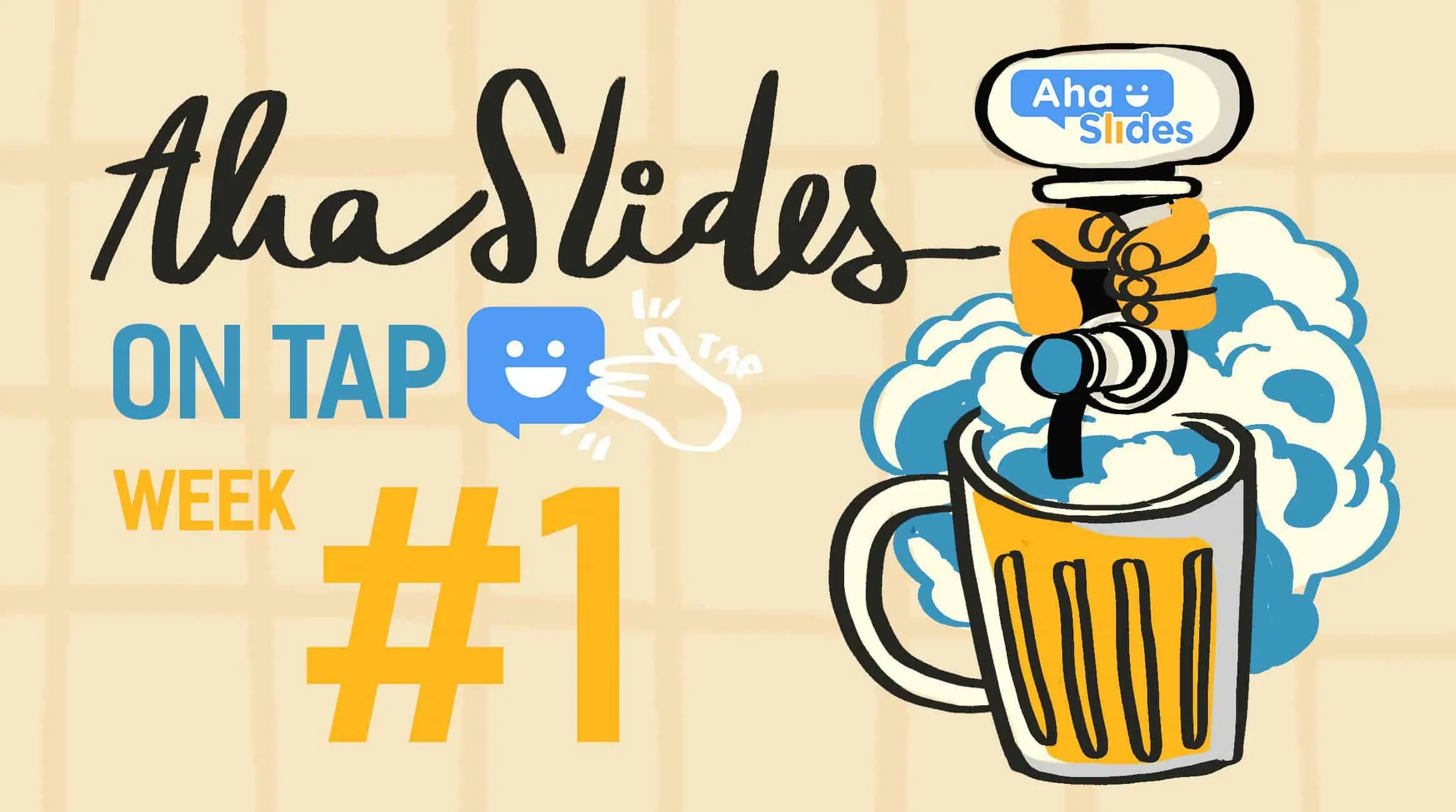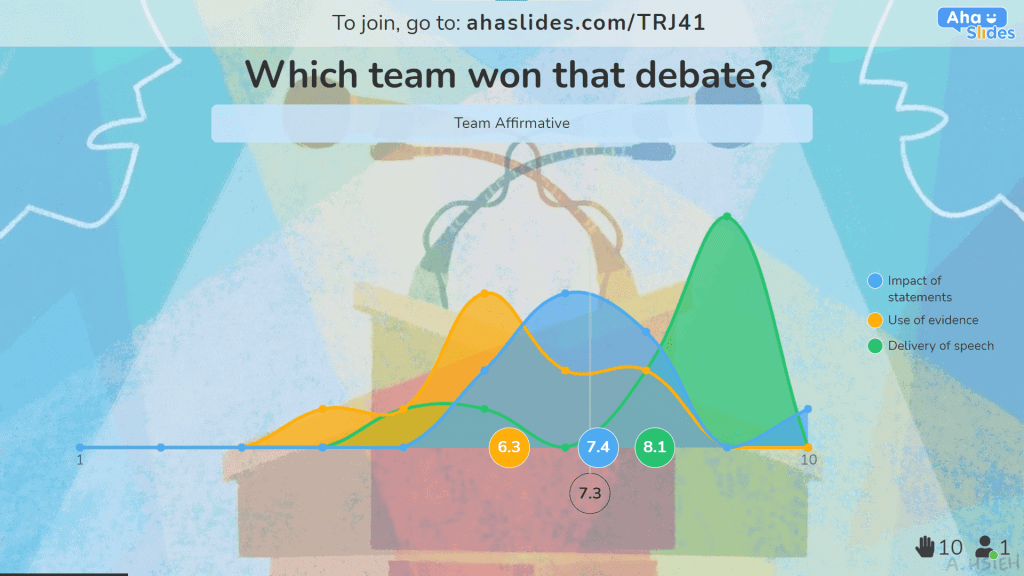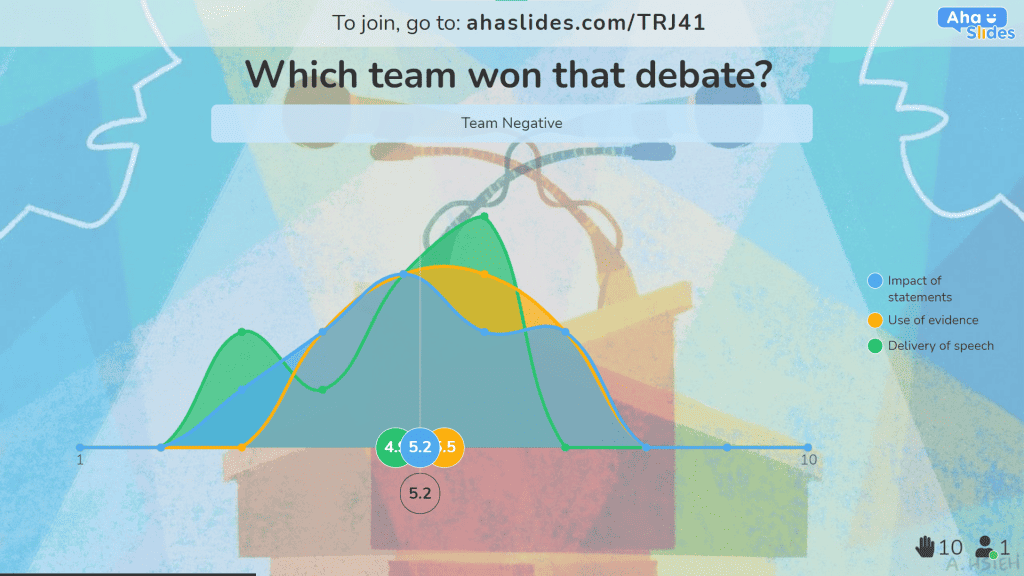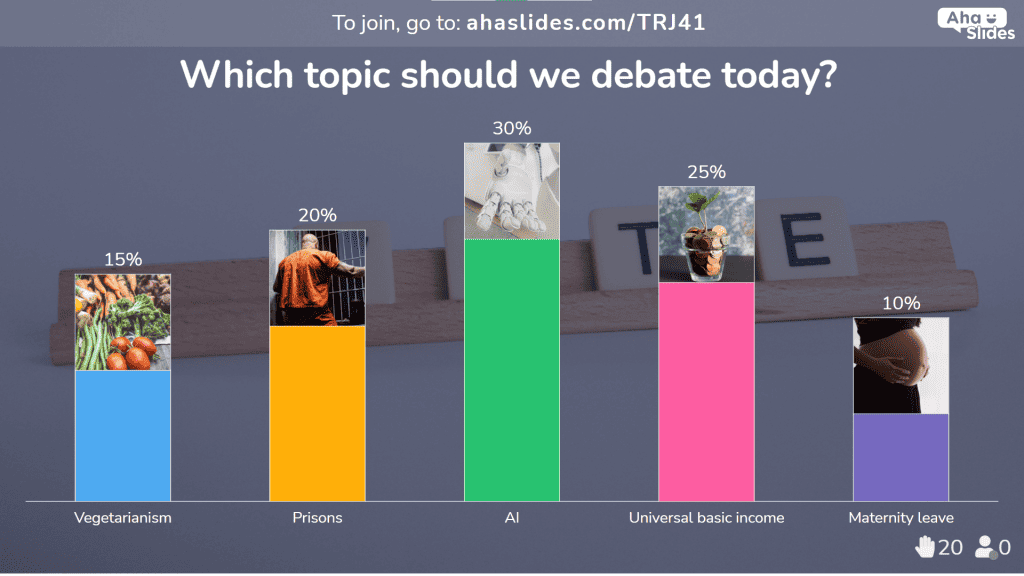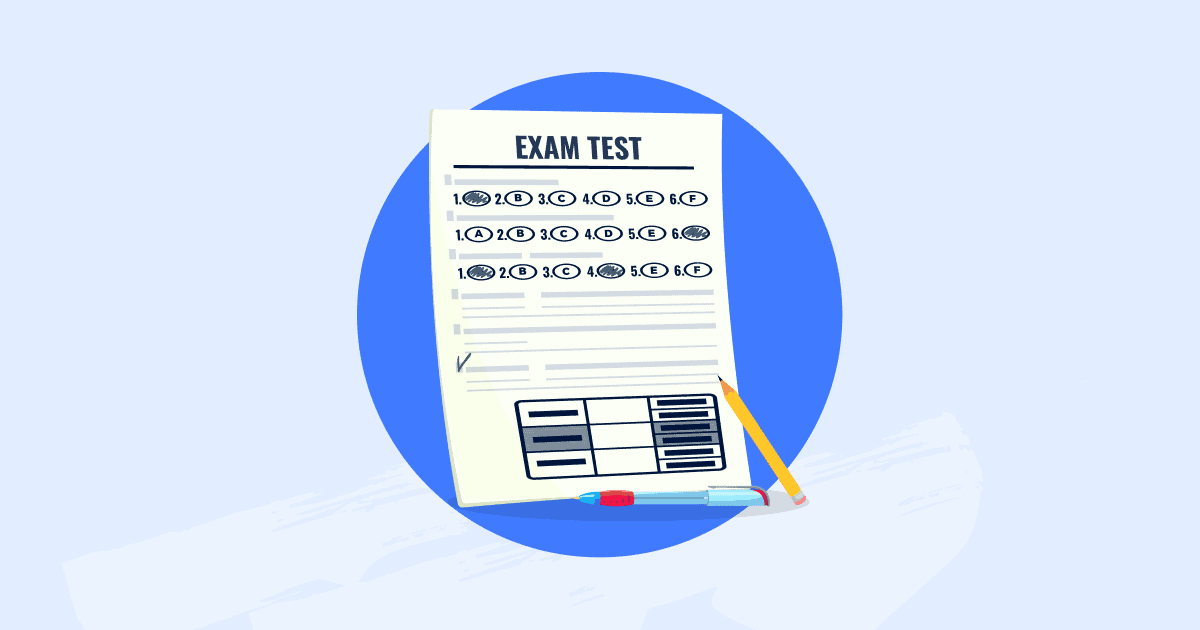यहाँ कोई बहस नहीं है; छात्र बहस आलोचनात्मक सोच को प्रोत्साहित करने के सर्वोत्तम तरीकों में से एक हैं, छात्रों को शामिल करें और शिक्षार्थियों के हाथों में सीखना।
तो, छात्र वाद-विवाद कैसे आयोजित करें? वे सिर्फ़ तर्क-वितर्क करने वाली कक्षाओं या नवोदित राजनेताओं के लिए नहीं हैं, और वे सिर्फ़ छोटे या ज़्यादा परिपक्व पाठ्यक्रमों के लिए नहीं हैं। छात्र वाद-विवाद सभी के लिए हैं, और वे सही मायने में स्कूली पाठ्यक्रम का मुख्य आधार बन रहे हैं।
यहाँ, हम में गोता लगाते हैं कक्षा बहस की दुनिया. हम लाभ और विभिन्न प्रकार के छात्र वाद-विवाद, साथ ही विषयों, एक महान उदाहरण और, महत्वपूर्ण रूप से, 6 सरल चरणों में अपनी स्वयं की उपयोगी, सार्थक कक्षा बहस को कैसे स्थापित करें, इसे देखते हैं।
हमारे बारे में अधिक जानें इंटरैक्टिव कक्षा गतिविधियाँ!
अवलोकन
| बहस कितने मिनट की होनी चाहिए? | 5 मिनट/सत्र |
| बहस का जनक कौन है? | प्रोटागोरस ऑफ़ अब्देरा |
| पहली बहस कब हुई थी? | 485-415 ईसा पूर्व |
AhaSlides के साथ अधिक सुझाव

सेकंड में शुरू करें।
निःशुल्क छात्र वाद-विवाद टेम्पलेट प्राप्त करें। मुफ्त में साइन अप करें और टेम्पलेट लाइब्रेरी से जो चाहें ले लें!
मुफ्त टेम्पलेट प्राप्त करें ️
छात्र वाद-विवाद कैसे आयोजित करें? विषय-सूची
- अवलोकन
- AhaSlides के साथ अधिक सुझाव
- छात्र वाद-विवाद को अधिक प्रेम की आवश्यकता क्यों है?
- छात्र वाद-विवाद आयोजित करने के लिए 6 कदम
- छात्र वाद-विवाद के 3 अलग-अलग प्रकार आजमाएं
- 40 छात्र वाद-विवाद विषय
- छात्र वाद-विवाद का आदर्श उदाहरण
- अक्सर पूछे जाने वाले प्रश्न
छात्र वाद-विवाद को अधिक प्यार की आवश्यकता क्यों है

कक्षा में नियमित रूप से होने वाली बहस किसी छात्र के जीवन के व्यक्तिगत और व्यावसायिक दोनों पहलुओं को गहराई से प्रभावित कर सकती है। यहाँ कुछ ऐसे तरीके दिए गए हैं जिनसे सार्थक कक्षा चर्चाएँ छात्रों के वर्तमान और भविष्य में एक सार्थक निवेश हो सकती हैं:
- अनुनय की शक्ति - छात्र वाद-विवाद से छात्रों को यह पता चलता है कि किसी भी गतिरोध के प्रति हमेशा एक चिंतनशील, डेटा-संचालित दृष्टिकोण होता है। छात्र सीखते हैं कि कैसे एक ठोस, मापा हुआ तर्क तैयार किया जाए जो भविष्य में रोज़मर्रा की घटनाओं में कुछ लोगों के लिए मददगार हो सकता है।
- सहनशीलता का गुण – दूसरी ओर, कक्षा में छात्रों के बीच बहस आयोजित करने से सुनने का कौशल भी विकसित होता है। यह छात्रों को उन विचारों को सच में सुनना सिखाता है जो उनके अपने विचारों से अलग हैं और उन मतभेदों के स्रोतों को समझना सिखाता है। बहस में हारने पर भी छात्रों को पता चलता है कि किसी मामले पर अपना विचार बदलना ठीक है।
- 100% ऑनलाइन संभव – ऐसे समय में जब शिक्षक अभी भी कक्षा में ऑनलाइन अनुभव को स्थानांतरित करने के लिए संघर्ष कर रहे हैं, छात्र वाद-विवाद एक परेशानी मुक्त गतिविधि प्रदान करते हैं जिसके लिए किसी भौतिक स्थान की आवश्यकता नहीं होती है। निश्चित रूप से इसमें बदलाव करने की आवश्यकता है, लेकिन ऐसा कोई कारण नहीं है कि छात्र वाद-विवाद ऑनलाइन शिक्षण के प्रति आपके दृष्टिकोण का हिस्सा न हों।
- छात्र केंद्रित - विषयों को नहीं, बल्कि छात्रों को सीखने के केंद्र में रखने के लाभ पहले से ही अच्छी तरह से पता लगाया गया है. एक छात्र वाद-विवाद शिक्षार्थियों को वे क्या कहते हैं, क्या करते हैं और कैसे प्रतिक्रिया देते हैं, इस पर कमोबेश स्वतंत्र शासन देता है।
छात्र वाद-विवाद आयोजित करने के लिए 6 कदम
चरण #1 – विषय का परिचय दें
वाद-विवाद संरचना के लिए, सबसे पहले, स्वाभाविक रूप से, स्कूल में बहस आयोजित करने के लिए पहला कदम उन्हें बात करने के लिए कुछ देना है। कक्षा में बहस के लिए विषयों का दायरा वस्तुतः असीमित है, यहाँ तक कि तात्कालिक बहस के विषय भी। आप कोई भी बयान दे सकते हैं, या कोई हाँ/नहीं प्रश्न पूछ सकते हैं, और जब तक आप बहस के नियमों को सुनिश्चित करते हैं तब तक दोनों पक्षों को इसे जारी रखने दें।
फिर भी, सबसे अच्छा विषय वह है जो आपकी कक्षा को यथासंभव बीच में विभाजित कर दे। यदि आपको कुछ प्रेरणा की आवश्यकता है, तो हमारे पास 40 छात्र वाद-विवाद विषय हैं यहाँ नीचे.
सही विषय चुनने का एक शानदार तरीका है अपनी कक्षा में इस पर प्रारंभिक राय एकत्रित करना, और यह देखते हुए कि किसके पास प्रत्येक तरफ छात्रों की संख्या कम या ज्यादा है:
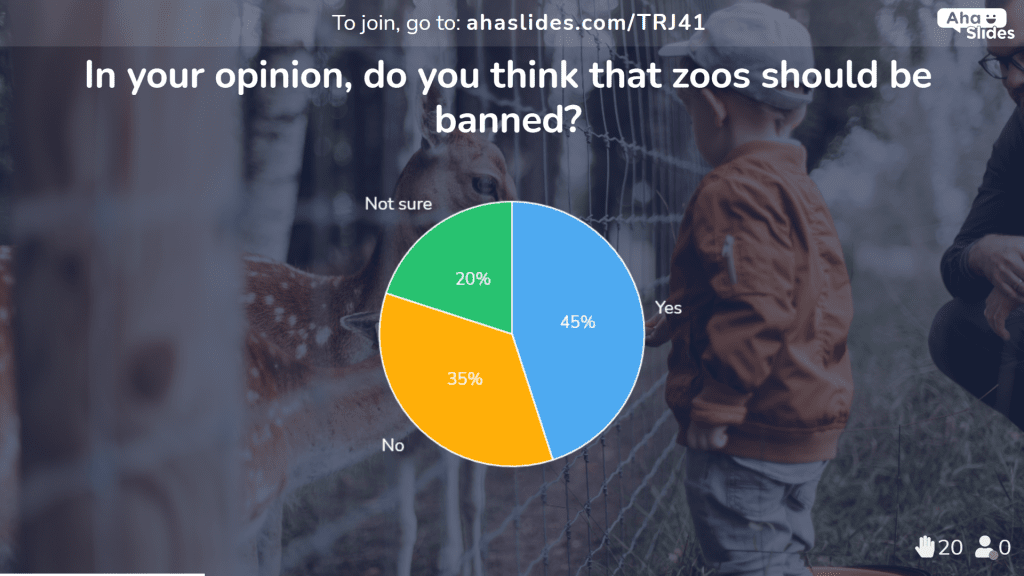
हालांकि ऊपर दिए गए जैसा एक साधारण हां/नहीं मतदान कर सकता है, आपके छात्रों के लिए चर्चा के लिए विषय को निर्धारित करने और सेट करने के कई अन्य रचनात्मक तरीके हैं:
- छवि सर्वेक्षण – कुछ चित्र प्रस्तुत करें और देखें कि प्रत्येक छात्र किससे सबसे अधिक पहचानता है।
- शब्द मेघ - देखें कि कक्षा में बच्चे अपनी राय व्यक्त करते समय कितनी बार एक ही शब्द का प्रयोग करते हैं।
- दर्ज़ा पैमाने – कथनों को स्लाइडिंग स्केल पर प्रस्तुत करें और छात्रों से सहमति के लिए 1 से 5 तक रेटिंग करवाएं।
- ओपन एंडेड सवाल – छात्रों को किसी विषय पर अपनी राय व्यक्त करने की स्वतंत्रता दें।
मुफ्त डाउनलोड! ⭐ आप इन सभी सवालों को नीचे दिए गए मुफ़्त AhaSlides टेम्पलेट में पा सकते हैं। आपके छात्र अपने फ़ोन के ज़रिए इन सवालों का लाइव जवाब दे सकते हैं, और फिर पूरी कक्षा की राय के बारे में विज़ुअलाइज़्ड डेटा देख सकते हैं।
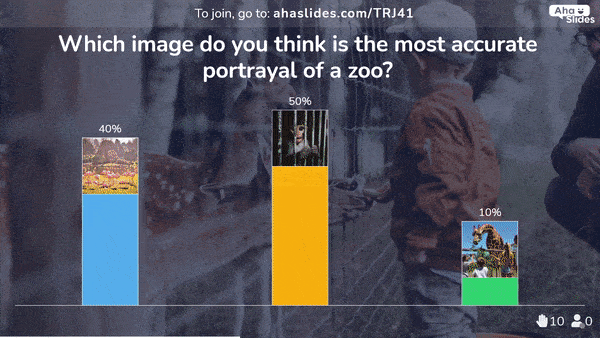
अहास्लाइड्स ने मंच खोल दिया है।
कक्षा में लाइव छात्रों की राय एकत्र करने के लिए इस मुफ्त, इंटरैक्टिव टेम्पलेट का उपयोग करें। सार्थक चर्चा शुरू करें। साइन-अप की आवश्यकता नहीं है!
मुफ्त टेम्पलेट को पकड़ो! ️
चरण #2 – टीम बनाएं और भूमिकाएं निर्धारित करें
बैग में विषय के साथ, अगला चरण इस पर चर्चा करते हुए 2 पक्ष बनाना है। वाद-विवाद में, इन पक्षों को के रूप में जाना जाता है सकारात्मक और नकारात्मक।
- टीम सकारात्मक - प्रस्तावित कथन से सहमत होने वाला पक्ष (या प्रस्तावित प्रश्न पर 'हां' में मतदान करना), जो आमतौर पर यथास्थिति में बदलाव होता है।
- टीम नकारात्मक - पक्ष प्रस्तावित कथन से असहमत है (या प्रस्तावित प्रश्न पर 'नहीं' वोट देता है) और चीजों को उसी तरह रखना चाहता है जैसे वे हैं।
दरअसल, 2 पक्ष ही वह न्यूनतम है जिसकी आपको आवश्यकता है। यदि आपके पास एक बड़ी कक्षा है या छात्रों की एक बड़ी संख्या है जो पूरी तरह से सकारात्मक या नकारात्मक के पक्ष में नहीं हैं, तो आप टीमों की संख्या बढ़ाकर सीखने की क्षमता का विस्तार कर सकते हैं।
- टीम मिडिल ग्राउंड - पक्ष यथास्थिति को बदलना चाहता है लेकिन फिर भी कुछ चीजें वैसी ही रखता है। वे किसी भी पक्ष की बातों का खंडन कर सकते हैं और दोनों के बीच समझौता कराने की कोशिश कर सकते हैं।
टिप #1 💡 तटस्थ रहने वालों को दंडित न करें। हालांकि छात्रों के बीच बहस का एक कारण यह भी है कि छात्रों को अपनी राय व्यक्त करने में अधिक आत्मविश्वास मिले, लेकिन कई बार ऐसा भी होता है कि वे अपनी राय व्यक्त करने में असमर्थ होते हैं। वास्तव में मध्य मैदान मेंउन्हें यह रुख अपनाने दीजिए, लेकिन उन्हें यह जान लेना चाहिए कि यह बहस से बाहर निकलने का रास्ता नहीं है।
आपकी बाकी कक्षा में शामिल होंगे न्यायाधीशोंवे बहस में प्रत्येक बिंदु को सुनेंगे और प्रत्येक टीम के समग्र प्रदर्शन को उसके परिणामों के आधार पर अंक देंगे। स्कोरिंग प्रणाली आप बाद में निकले।
जहाँ तक प्रत्येक वक्ता की टीम की भूमिका का सवाल है, आप इन्हें अपनी पसंद के अनुसार सेट कर सकते हैं। कक्षा में छात्रों की बहसों में एक लोकप्रिय प्रारूप ब्रिटिश संसद में इस्तेमाल किया जाने वाला प्रारूप है:
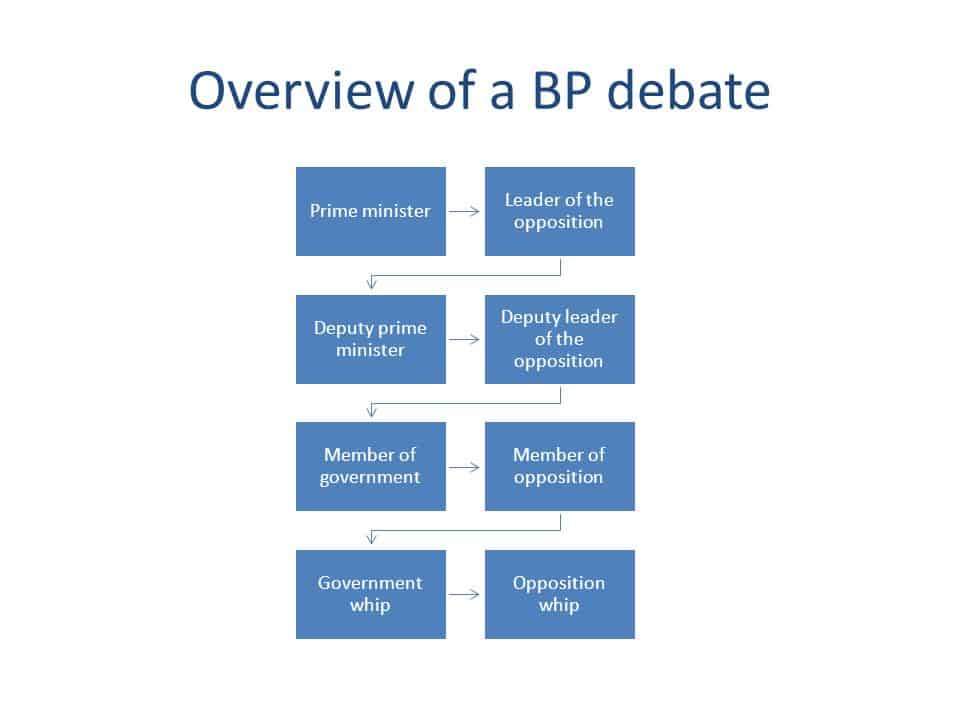
इसमें प्रत्येक टीम में 4 स्पीकर शामिल हैं, लेकिन आप प्रत्येक भूमिका के लिए दो छात्रों को असाइन करके और उन्हें आवंटित समय के दौरान प्रत्येक को एक अंक देकर बड़ी कक्षाओं के लिए इसका विस्तार कर सकते हैं।
चरण #3 – समझाएं कि यह कैसे काम करता है
एक छात्र बहस के 3 महत्वपूर्ण भाग हैं जिन्हें शुरू करने से पहले आपको स्पष्ट करना होगा। आप जिस तरह की अराजक बहस का अनुभव कर सकते हैं, उसके खिलाफ ये आपके बैरिकेड्स हैं वास्तविक ब्रिटिश संसद. और बहस के महत्वपूर्ण हिस्से हैं संरचना, नियम और स्कोरिंग प्रणाली.
- ढांचा -
सबसे पहले और सबसे महत्वपूर्ण, एक छात्र बहस के लिए एक ठोस संरचना और बहस दिशानिर्देशों का पालन करना आवश्यक है। यह होना जरूरी है पार्श्विक ताकि कोई भी एक दूसरे से बात नहीं कर सके, और इसे पर्याप्त अनुमति देने की आवश्यकता हो पहर शिक्षार्थियों को अपनी बात रखने के लिए।
इस उदाहरण छात्र बहस की संरचना देखें। बहस हमेशा टीम सकारात्मक से शुरू होती है और उसके बाद टीम नकारात्मक होती है
| टीम सकारात्मक | टीम नकारात्मक | प्रत्येक टीम के लिए समय भत्ता |
| उद्घाटन वक्तव्य 1 स्पीकर द्वारा। वे प्रस्तावित परिवर्तन के समर्थन के अपने मुख्य बिंदु बताएंगे | उद्घाटन वक्तव्य 1 स्पीकर द्वारा। वे प्रस्तावित परिवर्तन के समर्थन के अपने मुख्य बिंदु बताएंगे | 5 मिनट |
| खंडन तैयार करें. | खंडन तैयार करें. | 3 मिनट |
| खंडन दूसरे वक्ता द्वारा। वे टीम नेगेटिव के आरंभिक वक्तव्य में प्रस्तुत बिंदुओं के विरुद्ध तर्क देंगे। | खंडन दूसरे वक्ता द्वारा। वे टीम एफ़र्मेटिव के आरंभिक वक्तव्य में प्रस्तुत बिंदुओं के विरुद्ध तर्क देंगे। | 3 मिनट |
| दूसरा खंडन तीसरे वक्ता द्वारा। वे टीम नेगेटिव के खंडन का खंडन करेंगे। | दूसरा खंडन तीसरे वक्ता द्वारा। वे टीम अफर्मेटिव के खंडन का खंडन करेंगे। | 3 मिनट |
| खंडन और समापन विवरण तैयार करें। | खंडन और समापन विवरण तैयार करें। | 5 मिनट |
| अंतिम खंडन और समापन वक्तव्य चौथे वक्ता द्वारा। | अंतिम खंडन और समापन वक्तव्य चौथे वक्ता द्वारा। | 5 मिनट |
टिप #2 💡 जो काम करता है, उसके साथ प्रयोग करते समय एक छात्र बहस की संरचना लचीली हो सकती है पत्थर में स्थापित किया जाना चाहिए जब अंतिम संरचना तय हो जाए। घड़ी पर नज़र रखें और वक्ताओं को अपने समय सीमा से आगे न बढ़ने दें।
- नियम -
आपके नियमों की सख्ती इस बात पर निर्भर करती है कि आपकी कक्षा में शुरुआती बयानों को सुनने के बाद राजनीतिज्ञों में घुलमिल जाने की संभावना कितनी है। फिर भी, आप चाहे किसी को भी पढ़ाएँ, हमेशा बहुत ज़्यादा मुखर छात्र और ऐसे छात्र होंगे जो बोलना नहीं चाहते। स्पष्ट नियम आपको खेल के मैदान को समतल करने और सभी की भागीदारी को प्रोत्साहित करने में मदद करते हैं।
यहां कुछ ऐसे उदाहरण दिए गए हैं जिन्हें आप संभवतः अपनी कक्षा चर्चा में उपयोग करना चाहेंगे:
- संरचना से चिपके रहो! जब तुम्हारी बारी न हो तो बात मत करो।
- विषय पर रहें।
- गाली मत दो।
- व्यक्तिगत हमलों का सहारा नहीं।
— स्कोरिंग प्रणाली —
यद्यपि कक्षा में वाद-विवाद का उद्देश्य वास्तव में 'जीतना' नहीं होता है, फिर भी आप पाएंगे कि आपके विद्यार्थियों की स्वाभाविक प्रतिस्पर्धात्मकता कुछ अंक-आधारित शांति की मांग करती है।
आप इसके लिए अंक दे सकते हैं...
- प्रभावशाली बयान
- डेटा समर्थित साक्ष्य
- वाक्पटु वितरण
- मजबूत बॉडी लैंग्वेज
- प्रासंगिक दृश्यों का उपयोग
- विषय की सही समझ
बेशक, किसी बहस को आंकना कभी भी शुद्ध संख्याओं का खेल नहीं होता है। आपको, या जजों की आपकी टीम को, वाद-विवाद के प्रत्येक पक्ष को स्कोर करने के लिए अपने सर्वश्रेष्ठ विश्लेषणात्मक कौशल को सामने लाना चाहिए।
टिप #3 बहस के लिए एक ईएसएल कक्षा, जहां इस्तेमाल की गई भाषा अंकों की तुलना में बहुत अधिक महत्वपूर्ण है, आपको अलग-अलग व्याकरण संरचनाओं और उन्नत शब्दावली जैसे मानदंडों को पुरस्कृत करना चाहिए। वहीं, देशी भाषा का इस्तेमाल करने पर भी अंक काट सकते हैं।
चरण #4 – शोध और लेखन का समय

क्या सभी को विषय और कक्षा चर्चा के नियम स्पष्ट हैं? अच्छा! अब अपने तर्क तैयार करने का समय है।
आपकी ओर से, आपको यहाँ क्या करना है समय सीमा तय की अनुसंधान के लिए, कुछ निर्धारित करें पूर्व निर्धारित स्रोत जानकारी का, और फिर अपने छात्रों पर नज़र रखें ताकि यह सुनिश्चित हो सके कि वे विषय पर रहना.
उन्हें अपनी बातों पर शोध करना चाहिए और मंथन दूसरी टीम के संभावित खंडन को समझें और तय करें कि वे जवाब में क्या कहेंगे। इसी तरह, उन्हें अपने विरोधियों के तर्कों का अनुमान लगाना चाहिए और खंडन पर विचार करना चाहिए।
चरण #5 – कमरा (या ज़ूम) तैयार करें
जबकि आपकी टीमें अपने अंक अंतिम रूप दे रही हैं, शो की तैयारी का समय आ गया है।
कमरे में एक दूसरे के सामने टेबल और कुर्सियाँ रखकर पेशेवर बहस का माहौल बनाने की पूरी कोशिश करें। आम तौर पर, वक्ता अपनी टेबल के सामने पोडियम पर खड़ा होगा और अपनी बात समाप्त करने के बाद अपनी टेबल पर वापस आ जाएगा।
स्वाभाविक रूप से, अगर आप ऑनलाइन छात्र वाद-विवाद की मेज़बानी कर रहे हैं तो चीज़ें थोड़ी मुश्किल हो जाती हैं। फिर भी, कुछ मज़ेदार तरीके हैं जिनसे आप अपने छात्रों को ऑनलाइन बहस करने के लिए प्रेरित कर सकते हैं। ज़ूम पर टीमों को अलग करें:
- साथ आने के लिए प्रत्येक टीम प्राप्त करें टीम के रंग और अपने ज़ूम बैकग्राउंड को उनके साथ सजाने या उन्हें वर्दी के रूप में पहनने के लिए।
- प्रत्येक टीम को आविष्कार करने के लिए प्रोत्साहित करें a टीम शुभंकर और प्रत्येक सदस्य के लिए बहस करते समय इसे स्क्रीन पर दिखाना।
चरण # 6 – बहस!
लड़ाई शुरू होने दो!
याद रखें कि यह आपके छात्र के चमकने का समय है; जितना संभव हो उतना कम बोलने की कोशिश करें। अगर आपको बोलना है, तो सुनिश्चित करें कि यह सिर्फ़ कक्षा में व्यवस्था बनाए रखने या संरचना या स्कोरिंग सिस्टम को बताने के लिए हो। साथ ही, यहाँ कुछ सुझाव दिए गए हैं परिचय उदाहरण आपकी बहस में धमाल मचाने के लिए!
स्कोरिंग सिस्टम में आपके द्वारा निर्धारित मानदंडों पर प्रत्येक टीम को स्कोर देकर बहस को समाप्त करें। आपके जज बहस के दौरान प्रत्येक मानदंड के स्कोर भर सकते हैं, जिसके बाद स्कोर की गणना की जा सकती है, और प्रत्येक बार में औसत संख्या टीम का अंतिम स्कोर होगी।
टिप #4 💡 यह एक गहन बहस विश्लेषण में सीधे कूदने के लिए आकर्षक हो सकता है, लेकिन यह है अगले पाठ तक सर्वश्रेष्ठ सहेजा गया. छात्रों को आराम करने दें, बिंदुओं पर विचार करें और अगली बार उनका विश्लेषण करने के लिए वापस आएं।
कोशिश करने के लिए छात्र बहस के विभिन्न प्रकार
ऊपर की संरचना को कभी-कभी के रूप में संदर्भित किया जाता है लिंकन-डगलस प्रारूपअब्राहम लिंकन और स्टीफन डगलस के बीच तीखी बहस की एक श्रृंखला से प्रसिद्ध हुआ। हालाँकि, जब कक्षा में बहस करने की बात आती है तो टैंगो के एक से अधिक तरीके होते हैं:
- रोलप्ले डिबेट - छात्र किसी काल्पनिक या गैर-काल्पनिक चरित्र की राय पर आधारित बहस का अभिनय करते हैं। यह उनके दिमाग को खोलने और अपने विचारों से अलग विचारों के साथ एक ठोस तर्क पेश करने का एक शानदार तरीका है।
- तत्काल बहस - पॉप क्विज़ की तरह सोचें, लेकिन बहस के लिए! अचानक होने वाली छात्र बहसों में वक्ताओं को तैयारी करने का समय नहीं मिलता, जो तात्कालिक और आलोचनात्मक सोच कौशल का एक अच्छा अभ्यास है।
- टाउन हॉल बहस - दो या दो से अधिक छात्र दर्शकों के सामने खड़े होकर उनसे सवाल जवाब करते हैं। प्रत्येक पक्ष को प्रत्येक प्रश्न का उत्तर देने का मौका मिलता है और वे एक दूसरे का खंडन कर सकते हैं, बशर्ते कि यह कमोबेश सभ्य बना रहे!
13 बेहतरीन अद्भुत चीजें देखिए ऑनलाइन वाद-विवाद खेल सभी आयु वर्ग के विद्यार्थियों के लिए (+30 विषय)!

अपने छात्रों को शामिल करने के लिए और तरीकों की आवश्यकता है? 💡 इन्हें देखें 12 छात्र जुड़ाव विचार या फ़्लिप की कक्षा लाइव और ऑनलाइन कक्षाओं के लिए तकनीक!
40 छात्र वाद-विवाद विषय
क्या आप अपनी बहस को कक्षा के फर्श पर लाने के लिए कुछ प्रेरणा की तलाश कर रहे हैं? नीचे दिए गए इन 40 छात्र वाद-विवाद विषयों पर एक नज़र डालें और अपने छात्रों के साथ वोट करें कि किस पर चलना है।
छात्र वाद-विवाद के लिए स्कूल के विषय
- क्या हमें एक हाइब्रिड क्लासरूम बनाना चाहिए और रिमोट और इन-क्लास दोनों तरह से सीखना चाहिए?
- क्या हमें स्कूल में वर्दी पर प्रतिबंध लगा देना चाहिए?
- क्या हमें होमवर्क पर प्रतिबंध लगा देना चाहिए?
- क्या हमें सीखने के फ़्लिप्ड क्लासरूम मॉडल को आज़माना चाहिए?
- क्या हमें बाहर और अधिक सीखना चाहिए?
- क्या हमें परीक्षाएं समाप्त कर देनी चाहिए और पाठ्यक्रम के माध्यम से परीक्षण करना चाहिए?
- क्या सभी को विश्वविद्यालय जाना चाहिए?
- क्या यूनिवर्सिटी फीस कम होनी चाहिए?
- क्या हमारे पास निवेश पर एक वर्ग होना चाहिए?
- क्या एस्पोर्ट्स को जिम क्लास का हिस्सा होना चाहिए?
छात्र बहस के लिए पर्यावरण विषय for
- क्या हमें चिड़ियाघरों पर प्रतिबंध लगा देना चाहिए?
- क्या इसे विदेशी बिल्लियों को पालतू जानवर के रूप में रखने की अनुमति दी जानी चाहिए?
- क्या हमें और अधिक परमाणु ऊर्जा संयंत्र बनाने चाहिए?
- क्या हमें दुनिया भर में जन्म दर को धीमा करने की कोशिश करनी चाहिए?
- क्या हमें प्रतिबंध लगाना चाहिए सब सिंगल यूज प्लास्टिक?
- क्या हमें निजी लॉन को आवंटन और वन्यजीवों के आवास में बदलना चाहिए?
- क्या हमें 'पर्यावरण के लिए अंतर्राष्ट्रीय सरकार' शुरू करनी चाहिए?
- क्या हमें जलवायु परिवर्तन से निपटने के लिए लोगों को अपने तरीके बदलने के लिए बाध्य करना चाहिए?
- क्या हमें 'फास्ट फैशन' को हतोत्साहित करना चाहिए?
- क्या हमें छोटे देशों में अच्छी ट्रेन और बस प्रणाली के साथ घरेलू उड़ानों पर प्रतिबंध लगा देना चाहिए?
छात्र वाद-विवाद के लिए समाज के विषय
- क्या हमें सब शाकाहारी हो या शाकाहारी?
- क्या हमें वीडियो गेम खेलने का समय सीमित करना चाहिए?
- क्या हमें सोशल मीडिया पर बिताए जाने वाले समय को सीमित कर देना चाहिए?
- क्या हमें सभी बाथरूमों को लिंग-तटस्थ बनाना चाहिए?
- क्या हमें मातृत्व अवकाश की मानक अवधि बढ़ानी चाहिए?
- क्या हमें एआई का आविष्कार करते रहना चाहिए जो कर सकता है सब नौकरियां?
- क्या हमें यूनिवर्सल बेसिक इनकम होनी चाहिए?
- क्या जेल सजा या पुनर्वसन के लिए होनी चाहिए?
- क्या हमें सामाजिक ऋण प्रणाली अपनानी चाहिए?
- क्या हमें अपने डेटा का उपयोग करने वाले विज्ञापनों पर प्रतिबंध लगाना चाहिए?
छात्र वाद-विवाद के लिए काल्पनिक विषय
- यदि अमरत्व एक विकल्प होता, तो क्या आप इसे लेते?
- अगर चोरी को कानूनी बना दिया जाता, तो क्या आप ऐसा करते?
- अगर हम जानवरों को आसानी से और सस्ते में क्लोन कर सकते हैं, तो क्या हमें ऐसा करना चाहिए?
- अगर एक टीका रोक सकता है सब क्या यह एक फैलने वाली बीमारी है, इसलिए क्या हमें लोगों को इसे लेने के लिए मजबूर करना चाहिए?
- अगर हम पृथ्वी जैसे किसी दूसरे ग्रह पर आसानी से जा सकते हैं, तो क्या हमें?
- If नहीं जानवरों के विलुप्त होने का खतरा था, क्या सभी जानवरों की खेती वैध होनी चाहिए?
- यदि आप कभी काम न करने और फिर भी आराम से रहने का विकल्प चुन सकते हैं, तो क्या आप?
- यदि आप दुनिया में कहीं भी आराम से रहना चुन सकते हैं, तो क्या आप कल चलेंगे?
- यदि आप एक पिल्ला खरीदने या एक बड़े कुत्ते को अपनाने का विकल्प चुन सकते हैं, तो आप किसके लिए जाएंगे?
- अगर बाहर खाने की कीमत खुद के लिए खाना पकाने के बराबर होती, तो क्या आप हर दिन बाहर खाना खाते?
हो सकता है कि आप अपने छात्रों को इन वाद-विवाद विषयों का चयन देना चाहें, जिनके पास अंतिम निर्णय होगा कि किसको फर्श पर ले जाना है। आप इसके लिए एक साधारण सर्वेक्षण का उपयोग कर सकते हैं, या प्रत्येक विषय की विशेषताओं के बारे में अधिक सूक्ष्म प्रश्न पूछ सकते हैं, यह देखने के लिए कि छात्र किस विषय पर चर्चा करने में सबसे अधिक सहज हैं।
अपने छात्रों को मुफ्त में मतदान करें! ⭐ AhaSlides आपको छात्रों को कक्षा के केंद्र में रखने और लाइव पोलिंग, क्विज़िंग और विचारों के आदान-प्रदान के माध्यम से उन्हें आवाज़ देने में मदद करता है। छात्र जुड़ाव बढ़ाने के मामले में, कोई बहस नहीं है।
बिल्कुल सही छात्र वाद-विवाद उदाहरण
हम आपको कोरियाई प्रसारण नेटवर्क अरिरंग पर प्रसारित एक शो से छात्र वाद-विवाद के सबसे बेहतरीन उदाहरणों में से एक के साथ छोड़ेंगे। यह शो, बुद्धिमत्ता – हाई स्कूल वाद-विवाद, एक सुंदर छात्र बहस का लगभग हर पहलू है जिसे शिक्षकों को अपनी कक्षाओं में लाने की ख्वाहिश रखनी चाहिए।
इसकी जांच - पड़ताल करें:
टिप #5 💡 अपनी अपेक्षाओं को प्रबंधित करें। इस कार्यक्रम में शामिल बच्चे पूर्णतः पेशेवर हैं, और कई लोग अंग्रेजी को अपनी दूसरी भाषा के रूप में लेकर वाक्पटुता से बहस करते हैं। अपने छात्रों से उसी स्तर पर होने की उम्मीद न करें – आवश्यक भागीदारी एक अच्छी शुरुआत है!

छात्रों को अपनी बात कहने का मौका दें।
मतदान करें, प्रश्नोत्तरी करें और संवाद बनाकर अपनी कक्षा का विकास करें। AhaSlides कक्षाओं को इंटरैक्टिव बनाता है और छात्रों को शक्ति देता है।
इसे निःशुल्क आज़माएँ ☁️
अक्सर पूछे जाने वाले प्रश्न
क्या आपके पास कोई प्रश्न है? हमारे पास उत्तर हैं।
